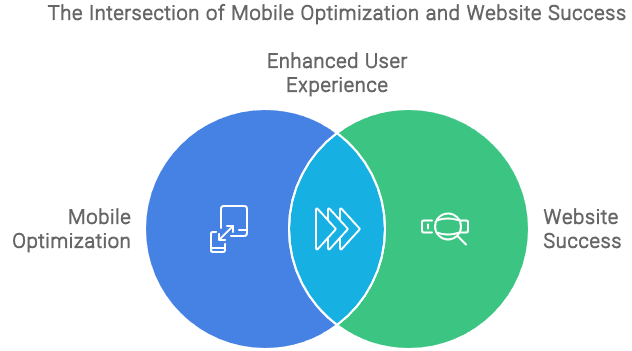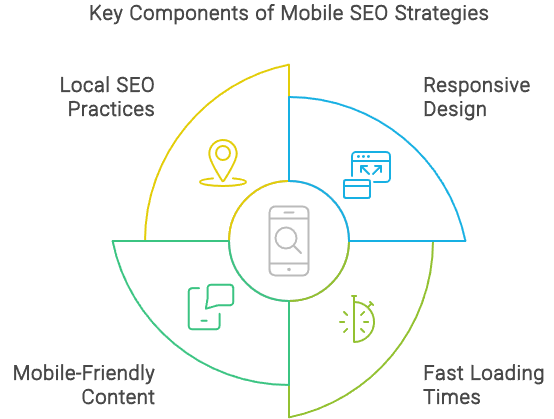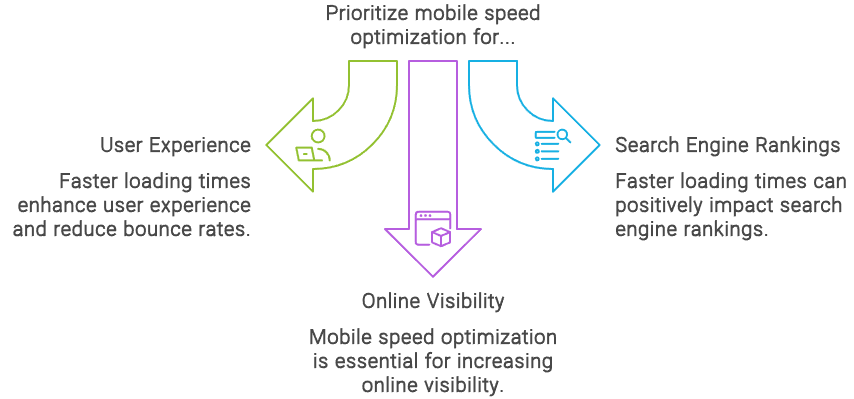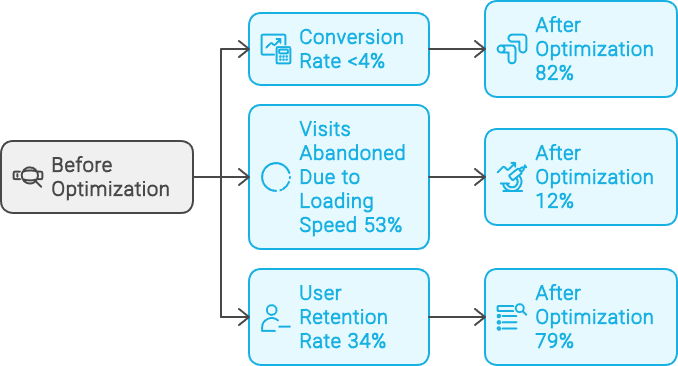Mobile Optimization Basics

Importance of Mobile-Friendly Websites
Mobile optimization for websites is more important than ever. As user behavior shifts toward mobile devices, businesses must adapt to remain competitive. Currently, 51.3% of all internet usage occurs on mobile devices. Google and other search engines prioritize mobile-friendly websites, making it essential for you to ensure your site is optimized for various screen sizes.
Mobile optimization involves implementing strategies that enhance user experience on mobile devices. This includes optimizing layout, content, speed, responsiveness, and navigation. When your site is mobile-friendly, it not only improves customer perception but also enhances your search engine rankings and visibility.
| Mobile Usage Statistics | Percentage |
|---|---|
| Internet usage on mobile devices | 51.3% |
| Importance for businesses to optimize | High |
Strategies for Mobile SEO
To effectively enhance your mobile presence, consider adopting various mobile SEO strategies. Here are some critical practices that can significantly improve your website’s performance on mobile:
- Responsive Design: Utilize responsive design to ensure your website adapts seamlessly to different screen sizes. This approach enhances usability and ensures a consistent experience across devices.
- Optimize Page Speed: Google announced that mobile page speed is a ranking factor for SEO in July 2018. Use tools such as Google’s PageSpeed Insights to analyze and improve your mobile page speed.
- Content Optimization: Ensure your content is readable on mobile devices. Use shorter paragraphs, clear headings, and bullet points to enhance readability.
- Mobile-Friendly Navigation: Streamline your navigation for mobile users. Simplified menus and clear call-to-actions can improve user engagement and reduce bounce rates.
- Local SEO: As a local business owner, optimizing for local searches can drive traffic to your site and boost foot traffic to your location. Implement local SEO strategies such as adding your business to Google My Business and using locally relevant keywords.
Implementing these strategies will not only help you align with best practices but also enhance your customer’s experience, leading to higher engagement and conversions. For more in-depth information on optimizing your site, refer to our resources on seo optimization best practices and on-page seo optimization techniques.
Components of Mobile Optimization

To effectively implement mobile optimization for websites, several key components must be considered. These components include responsive design essentials, mobile speed optimization, and navigation tailored for mobile users.
Responsive Design Essentials
Responsive web design is critical for ensuring that your website functions well on all devices, particularly mobile. Google announced in 2015 that it would boost the ranking of mobile-friendly pages in mobile search results. By adopting responsive design principles, you allow your website to adapt to various screen sizes and orientations, ensuring a seamless user experience across different platforms.
| Key Elements of Responsive Design | Description |
|---|---|
| Fluid Grids | Layouts that use percentages instead of fixed sizes for elements. |
| Media Queries | CSS techniques that apply styles based on device characteristics. |
| Flexible Images | Images that scale and adjust according to the screen size. |
Mobile Speed Optimization

Page speed is a major factor that influences both search rankings and user experience. Optimizing your mobile site’s speed involves minimizing round trip requests, eliminating render-blocking elements, and using techniques like lazy loading, compression, and caching. Additionally, you can consider implementing the Accelerated Mobile Page (AMP) HTML structure, which aims to load pages in about one second, enhancing mobile speed.
| Optimization Technique | Description |
|---|---|
| Lazy Loading | Images load only when they enter the viewport, reducing initial load time. |
| Compression | Reducing file sizes to lower data usage and improve load times. |
| Caching | Storing frequently accessed data to speed up page loading. |
Navigation for Mobile Sites
Effective navigation is essential for mobile users, who interact with smaller screens. Mobile-friendly navigation requires different models compared to desktop versions. Key elements include using hamburger menus to save space and keeping text concise to maintain a clean interface. These strategies guide users to essential pages without cluttering the layout.
| Navigation Elements | Best Practices |
|---|---|
| Hamburger Menus | Provide a simple way to access a full menu without taking up screen space. |
| Concise Text | Use short phrases for headings and labels to enhance readability. |
| Sticky Navigation | Keep essential navigation links at the top of the screen as users scroll. |
By focusing on these vital components, you can significantly enhance the user experience and improve your website’s overall performance on mobile devices. Learn more about SEO optimization best practices and conduct a thorough review using our SEO site audit checklist to ensure your website meets these important criteria.
Impact of Mobile Optimization

The importance of mobile optimization for websites cannot be overstated. It significantly influences visitor engagement, retention, and sales. This section looks at case studies that highlight successes due to mobile optimization and how it translates into increased revenue for businesses.
Case Studies and Success Stories
Numerous businesses have transformed their operations and increased conversions by prioritizing mobile optimization. For example, Bryan Clayton, CEO of GreenPal, discovered that 4-to-1 more users accessed his site via mobile devices compared to desktops. After revamping the website to provide a mobile-first experience, the conversion rate skyrocketed from less than 4% to an impressive 82% (DreamHost). This case demonstrates how critical it is to cater to mobile users in today’s digital landscape.
Another compelling statistic comes from a survey that indicates 79% of users are more likely to revisit a site if it’s easy to navigate on their mobile device. This ease of use not only promotes repeat visits but also encourages users to share the site with others, creating a network effect that reduces marketing costs while boosting conversion rates.
Revenue Growth Through Mobile
The shift towards mobile devices isn’t just a trend—it’s the future of online presence. Google has confirmed that they prioritize mobile-friendly pages in their search results, influencing over 64% of total searches conducted on mobile devices (HubSpot). Understanding the significance of this traffic can directly impact your bottom line.
The consequences of neglecting mobile optimization can be steep. Research reveals that 53% of users abandon a mobile site if it takes more than 3 seconds to load. The speed of your mobile site is crucial; slow-loading pages can lead to lost revenue opportunities.
To illustrate the financial impact, consider that having a mobile-optimized website can lead to significant increases in sales. Local businesses, e-commerce entrepreneurs, and content creators can foster better engagement and drive conversions. This is evidenced by the growth statistics below:

Optimizing your site for mobile can result in dramatic enhancements to your engagement metrics, thereby positively affecting your revenue. For a strategic approach, consider utilizing seo optimization services or implementing on-page seo optimization techniques to ensure your mobile site is up to par with best practices.
Tools and Testing for Mobile SEO
Optimizing your website for mobile users requires effective tools and testing strategies to ensure a seamless experience. By utilizing the right resources, you can boost your site’s mobile performance and improve user retention.
Evaluation and Improvement Tools
Several tools are available to help you assess and enhance your website’s mobile-friendliness. Here are some of the most effective ones:
| Tool | Description |
|---|---|
| Google Search Console | Provides insights on mobile usability issues and helps track website performance. |
| PageSpeed Insights | Offers ratings on performance metrics that affect user experience and actionable tips for improvements. |
| Bing Mobile Friendliness Test Tool | Analyzes your mobile site’s performance and identifies areas for enhancement. |
| WebPageTest | Allows you to test your website from different devices and provides detailed reports on loading times. |
| BrowserStack | Simulates different mobile devices to check how your site appears and functions on them. |
Incorporating Accelerated Mobile Pages (AMP) is another strategic move. This framework helps load mobile websites in approximately one second, simplifying HTML and significantly enhancing mobile speed (Flowmatters).
Testing Strategies for Mobile-Friendly Sites
To ensure your site is optimized for mobile users, implement the following testing strategies:
- Performance Goals: Aim to have your pages load in less than 3 seconds. Google recommends achieving loading times under 1 to 2 seconds for optimal user experience (Mailchimp).
- Mobile Usability Testing: Regularly use tools like Google Search Console and PageSpeed Insights to monitor site performance and identify usability issues.
- Navigation Design: Since smaller screens necessitate different navigation designs, adopt elements like hamburger menus. Keep text concise to facilitate a clean interface that directs users to essential pages (BrowserStack).
- User Feedback: Collect feedback from mobile users to understand their experience. This feedback can guide necessary adjustments for usability improvements.
- Competitor Analysis: Review the mobile optimization of your competitors to identify industry standards and discover new strategies that could enhance your site.
By employing these tools and strategies, you can effectively assess and improve your mobile site’s performance, ensuring it meets user expectations and stays competitive in search rankings. For more insights on best practices, consider reviewing our comprehensive guide on seo optimization best practices.

